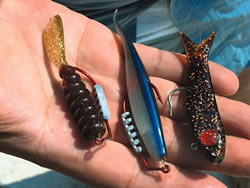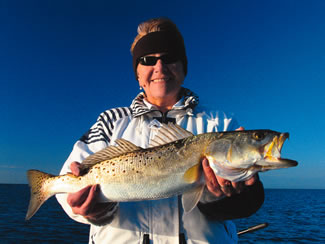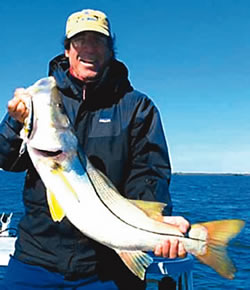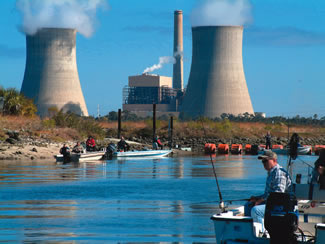February 01, 2006
By Tommy Thompson
Interested in free hot water? So are the fish.

Three very consistent artificials. |
Running off to join the circus” has a different meaning in Levy and Citrus County households during the coldest winter months. Those fleeing are not packing their possessions in a hobo kit and they don't have Ringling Brothers in mind. No sir. They're towing their boats to Yankeetown or Crystal River and thinking about fishing. Fishing in warm water, that is, the hot water discharge at the Crystal River Energy Complex. That's the spot known locally as “the circus,” one of the busiest cold-weather spots on the Big Bend.
Progress Energy's Crystal River site is comprised of five power plants, one nuclear and the other four fueled by coal. And no, to answer that first common question, the fish taken there don't glow or have Godzilla-like mutations! In terms of fishing, though, three of the plants use re-circulating cooling systems that take in and eject huge volumes of seawater, to condense the pressurized steam produced. The water is taken into the cooling systems from Crystal Bay, just south of the spoil banks created during the construction of the intake and shipping channel, at ambient temperature. After use by the plants, during which it is heated significantly, the water is pumped out into the southern end of Withlacoochee Bay.
One byproduct of the plants is millions of gallons of warm water. That's not a big news item during summer, when local seawater is in the upper 80s and plenty of fish are scattered across the area. However, when Gulf temperatures drop into the 50s and there's no hope of warmer days in the near future, that warm discharge really attracts fish.

February is catch-and-release only for spotted seatrout in this part of the state. |
The actual discharge is far up inside a canal. In recent years, due to security issues, Progress Energy has closed the eastern end of the discharge to boaters and fishermen, making the water in the western quarter-mile the warmest fishing spot. A string of rigid buoys blocks the mouth of the canal, allowing boats no farther. Discharge water is certainly warmer upstream from the buoys, but that doesn't stop fish from moving up and down the canal. Some anglers even feel the water is almost too hot closer to the plant, such as the buoy line, and it's better to fish farther away from the buoys. Whatever the mechanics of the situation, this place is a haven for all sorts of fish that mostly seek the warm water and the bait hanging around there.
The actual area known to locals as the circus isn't really very big, thus its name when 25 or so boats are “camped out” there on busy days. From the buoy line marking the restricted area to the end of the jetty at Rocky Point is only a mile and the channel is about 75 feet wide. That's not much water when a number of boats are arriving, departing, trolling, drifting or anchoring. Lots of action can mean confusion.
Fishing here is a cold-weather game. Cool is good, but bitter cold is better. The best time to fish the hot-water discharge is after a big cold front passes, during the bluebird days that follow. It's even better to catch an extreme low tide that happens an hour after sunup, and fish a couple of hours on either side. You'll be miserable getting there, but you'll warm up quickly as the radiant heat from the hot water warms your boat and the fishing keeps you active.

Carlton Roberts caught a 14-pound snook--rare in the area--in late January 2005 |
While finding a spot to fish in the discharge channel may be difficult, the actual fishing is easy, the perfect place to take out-of-town holiday guests. The most popular rig is a 3/8-ounce jighead adorned with a live shrimp fished slowly across the bottom of the canal. Many anglers prefer to break the tail off the bait and thread the hook from back to front. The broken tail supposedly puts a bit more scent into the water and the backwards rigging makes the retrieve more lifelike. Other popular baits are natural-looking jigs or grubs, and many fishermen tip their standard flats jigs with shrimp pieces or artificial flavoring.
A popular cold weather quarry here is seatrout, attracted in droves. “Droves” might be excessive, but “schools” are certainly not. There are moments when multiple hookups from surrounding boats is not an unusual sight. These are not big fish, but what they lack in size (mostly 15- to 20-inch slot fish), they make up in quantity and feistiness. In fact, there are times during February (when trout season is closed here) that they become downright pesky when you're questing for redfish.
Other more adventurous anglers are willing to sort out their trout and reds from an assortment of bycatch catfish, small sharks and stingrays, by soaking cut mullet down deep. If tugs and pulls is your game, that's the way to go, but smaller, moving baits are best for sport fish here. Speaking of sport fish, don't miss an opportunity to throw baits at one of the many schools of jack crevalle that cruise the channel at all times. Some exceed 10 pounds, and boating one will add spice to one's day.
Another technique overlooked by many is trolling the hot-water channel. The entire length of the canal is a slow-speed manatee zone during the cold months, and there's no better time to toss a medium-diver plug behind the boat. The water is about 15 feet deep and dragging these plugs at 4 to 5 knots can attract strikes from those jacks, as well as grouper, snook and tarpon.
No matter your choice of tackle, be prepared to leave some behind. The bottom of the channel is littered with lime rock and the remnants of years of snagged tackle. If you snag up on the bottom, you'll probably have to break off. If you snag another angler's line, just be courteous and work it out with him. There's usually lots of unhooking fouled lines as the currents are quick and the crowds are...well, you know, thick.

Area of Roberts' catch (above). |
If you're claustrophobic and hope to avoid the crowds, take a look at a good inshore chart and notice there's a line of rock and oyster bars running all the way from The Suncoast Keys near Ozello north to the mouth of the Waccasassa River. The section of those bars to the west of the discharge canal, taken in conjunction with the spoil banks to the south and a series of islands to the north, effectively creates a sealed environment where the hot water flows. Even though there's still a good tidal flow in the area, it's apparent from the number of fish taken in the general vicinity during cold weather that the outflow affects more than just the channel. Look for bars and island edges and points that hold baitfish such as mullet. While the water's not as warm here, bait will move away from the hot water discharge, particularly on higher tides, and range toward sunny oyster and shell bars. It's here that you'll have good luck in finding bigger, hardier fish capable of ranging into cooler water.
Many argue that fishing along this stretch of coast would be better without the plant, while others disagree. Certainly, the north-south tidal flow has been redirected by the power company shipping channel spoil banks, but the spoils created by the dredging of the now-defunct Cross Florida Barge Canal didn't help either. Tides do run strong in the area, successfully flushing the water several times a day, nurturing the seagrasses necessary to support marine life and procreation. The general area affected by the plants is probably “alive” more months now than before construction, due to the yearly supply of warm water and increased water movement. Taken together, this off-season fishery created by the Crystal River Energy Center is a terrific resource for Florida anglers, even if it does become a circus at times.
Getting There
Accessing the hot-water discharge can be difficult. There is a large and deep navigable channel running into the plants' cold-water intake on the Crystal Bay side of the site. That's great for large, oceangoing tugs pushing coal barges, but little help for anglers on the bay. Deeper water to the west of the Progress Energy site is largely man-made, and carved out of a very shallow, rocky bay. Getting there means crossing some potentially cruel and rocky bottom, so take care in larger boats and especially on low winter tides.
While launching is possible at the Fort Island ramps at Crystal River, the boat run to the hot-water discharge involves crossing lots of open water and then running out the intake channel a mile or two until you can pass between the spoil banks. Until it silted in, there was a cut near markers 43 and 44 called “Fisherman's Cut” that made for a simple transit of the spoil banks. Rumors have it that it will soon be re-opened during an upcoming dredging project at the intake channel.
Better boat launching possibilities are from the north. There's a good ramp at the end of SR40 in Yankeetown and Yankeetown Marina upriver. Either way, run out the river to marker 18A, then steer for marker 33 in the Cross Florida Barge Canal. Once there, take the cut between Barge Canal markers 32 and 34 and head directly for Fisherman's Cut. Once you're due west of the plant, slow down and “feel” your way in. Don't take anything for granted here, as big piles of local lime rock have a tendency to reach up and snag lower units. Another option from the north side of the plants is the launching ramp under the US19 Bridge over the Barge Canal near the FWC facility. Run out the Barge Canal to markers 32 and 34, and then head toward Fisherman's Cut.
FS
